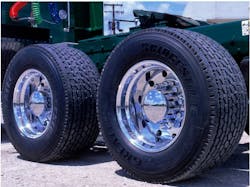'Lightweighting' pays multiple dividends for trucking
Truck operators looking to increase fuel efficiency and haul more freight can look to lightweighting as a key enabler, according to a recent Confidence Report on Lightweighting by Trucking Efficiency. The report found that investing in lightweighting is an attractive and economical alternative to adding expensive new equipment—and the potential savings are significant.
Trucking Efficiency is an initiative of the North American Council for Freight Efficiency (NACFE) and the Carbon War Room (CWR) that aims to double the efficiency of the North American trucking fleet.
“When lightweighting is looked at not only in terms of better fuel economy but also improved freight efficiency, it makes sense in a wide variety of applications,” said Mike Roeth, operation lead at Trucking Efficiency.
Lightweighting investments have already been made by the majority of bulk carriers, and current industry trends make it worthwhile for more carriers to adopt lightweighting technologies. NACFE estimates that over the next 5-10 years the number of refrigerated and dry vans requested to operate at maximum weight will double and lightweighting can help move their freight more efficiently, resulting in significant fuel savings and emissions reductions.
One technology with a proven track record of helping OEMs achieve lightweighting goals in vehicles of all types is aluminum. Research conducted by Ricardo Consulting Engineers has shown that an “aluminum-intensive” Class 8 commercial tractor trailer can reduce vehicle weight by 3,300 lbs. For every 10% of weight reduction, up to a 5.5% improvement in fuel economy is possible. The study also found that substituting the nation’s fleet of Class 8 tractor-trailers with aluminum-intensive models would save 9.3 million tons of CO2 annually.
“Aluminum is well-positioned to help move the nation’s freight more efficiently and effectively by providing lightweight solutions in a variety of applications across the heavy and medium duty truck markets,” said Heidi Brock, president & CEO of the Aluminum Association. “With the pending proposal from EPA to further tighten the emissions profile of the heavy duty truck and trailer market, this report shows how lightweighting with aluminum can be part of the fuel and freight efficiency solution.”
The need to trim vehicle weight in the medium and heavy-duty truck market stems from a variety of factors. Emissions regulations, fuel economy features and driver amenities have all added an average of 1,000 lbs. to the average tractor over the past decade. As expectations of more pallets per trailer and denser freight, fuel costs and number of weight restrictions rise, lightweighting becomes an increasingly attractive solution.
Other highlights from the study include:
A typical 100 truck fleet would save almost $100,000/year in diesel costs with 2,500 lbs. of weight saved per truck.
- Additionally, every pound shaved off the vehicle’s weight could be recouped as freight.
- Lightweighting retains its value even if fleets hope to continue shipping even their current quantities of freight.
- Lightweighting can help offset the added weight of fuel efficiency technologies.
The Aluminum Association’s Heavy Truck Working Group provided partial sponsorship of the lightweighting confidence report with support from its member companies Alcoa, Kaiser Aluminum, Metal Exchange Corporation, Novelis, Rio Tinto and Sapa. The Working Group is interested in freight and fuel efficiency improvements in the medium and heavy duty truck and trailer markets.
More information about aluminum’s role in lightweighting solutions for the transportation market can be found at http://www.aluminum.org/ and http://www.drivealuminum.org/.
The Confidence Report on Lightweighting is available for download at www.truckingefficiency.org.

